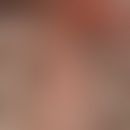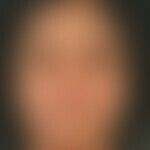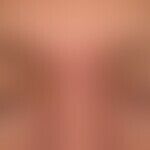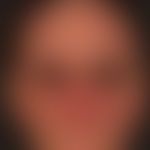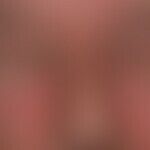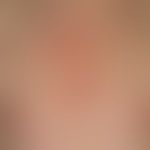Synonym(s)
DefinitionThis section has been translated automatically.
Common, genetically predisposed, chronic dermatitis affecting the seborrheic zones, prone to recurrence, usually relatively mild with a seasonal course (improvement in the summer months). Its independence and etiology are controversial.
You might also be interested in
Occurrence/EpidemiologyThis section has been translated automatically.
Prevalence (Central Europe): 3-10 % of the population.
Considering the diverse spectrum of seborrheic dermatitis, including the manifestations in infancy, almost everyone has experienced this disease once.
EtiopathogenesisThis section has been translated automatically.
It is assumed that the disease is based on a genetic predisposition, whereby various external and internal influences (e.g. microbial colonization, climate, stress) can lead to the outbreak.
The nosological position has been disputed since the first description by Josef Jakob Plenk.
Unna described a "chronic parasitic dermatitis characterized by abnormal fat content of the most superficial epidermal layers."
In case of a dysfunction of the sebaceous glands on the one hand a minus variant of psoriasis or the initiation or the influence of the resident flora of the skin especially by Malassezia spp. (in particular Malassezia globosa) is discussed.
This still controversial etiopathogenetic connection was already suspected in 1874 by Louis-Charles Malassez, after whom Malassezia spp. are named. Versch. Investigations suggest this assumption for the infantile as well as for the adult type. However, other studies found no difference in scalp colonization between affected and unaffected individuals.
Seborrheic dermatitis occurs more frequently in HIV-infected individuals (30% of HIV patients with LAS (= lymphadenopathy syndrome) develop seborrheic dermatitis). Parkinson's disease also aggravates the disease, about 50-60 % of the patients are affected (source Arsic Arsenijevic).
In many countries there is a seasonal dependence of the disease with a peak in winter.
ManifestationThis section has been translated automatically.
- Type I: Occurring in infancy, manifesting in the first 3 months of life. The clinical course is self-limiting.
- Type II: Occurring during the 3rd-5th decade of life (phases of high sebaceous gland activity); males are affected significantly more often than females. A genetic disposition has not been described. Dry form of capillitium affection especially beyond the 5th decade of life and in senility.
- In case of infestation of the capillitium more often sleep-deprived and stress-triggered.
Extensive, acute forms of seborrheic dermatitis should, among other things, make one think of a predisposing HIV infection.
LocalizationThis section has been translated automatically.
Seborrheic zones: face (eyebrows, nasolabial, retroauricular), often on the capillitium.
Other localizations: Beard area, intertriginous, pre-sternal, occasionally genital (especially in men), on the back.
ClinicThis section has been translated automatically.
The clinical picture of seborrheic dermatitis varies according to the location:
Capillitium: The capillitium is preferentially affected. It is characterized by few, sharply defined, two-dimensional rednesses (these can also be completely absent) with dense, non-adherent, white scaling of the head (dandruff). The hairline borders are usually not crossed (DD: Psoriasis capitis, where this border is usually crossed). Itching is absent or only mild. Not infrequently, seborrheic dermatitis of the capillitium is accompanied by a presumably "inflammation-related" effluvium, which may be reversible under sufficient therapy.
The term"seborrheic eczematid" is used to describe the mildest form of seborrheic dermatitis with discrete erythema and fine scaling, which not infrequently occurs with seborrhea.
Face: The centrofacial "seborrheic skin areas" such as mid-forehead, perinasal region, also preauricular and retroauricular are affected with red, marginal, scaly plaques with varying degrees of fine to mitellamellous scaling. In some patients, preferably young women, scaly erythema is found only paranasally(erythema paranasale). The course is highly chronic (Bieber T 2018).
Eyelids: The eyelids may be affected as part of a generalized seborrheic dermatitis. However, eyelid involvement may also manifest as a monotopic course(blepharitis chronica eczematosa). Experience has shown that it is resistant to therapy and eminently persistent, especially since a long-term therapy with a corticosteroid externum has usually preceded the visit to the specialist (see also eyelid dermatitis).
Trunk: Here, the central seborrheic zones (sweat grooves in the sternal area, along the spine, shoulder girdle) are affected, sometimes also the axillae. Figured, little or no itching, scaling of varying intensity, usually localized, sharply demarcated, red or red-brown patches, papules, or confluent plaques are seen.
Some skin lesions appear marginalized and are then difficult to differentiate differentially from tinea corporis or (seborrheic) psoriasis vulgaris.
Pityriasiform seborrhoid: Very rarely, a truncal exanthematous acute or subacute course reminiscent of pityriasis rosea is observed. In contrast to pityriasis rosea, the primary plaque and a distinct collerette scaling are absent (Bieber T 2018).
HistologyThis section has been translated automatically.
The histological picture is not specific for "seborrheic dermatitis". Usually there is a varying intensity of acanthotic widened epidermis with orthohyperkeratosis and focal parahyperkeratosis (parakeratosis mounds). Frequent loss of basket weave structure. Papillary dermis shows rather low-grade edema. Bulky, perivascularly oriented, but also diffuse predominantly lymphocytic infiltrate. Focal epidermotropy with mild (even absent) spongiosis. Biocompetent, numerous yeast elements (in the subacute form) may be seen in the keratin layer (source below).
Fact Sheet:
- psoriasiform epidermihyperplasia
- low-grade spongiosis with accentuation of the infundibula
- low-grade superficial perivascular lymphocyte iniflitrate
- Parakeratosis mound
Differential diagnosisThis section has been translated automatically.
Depending on the infestation pattern and localizations, different diseases come into question:
Capillitium:
- Tinea capitis: microscopic and cell-culture proof of fungus!
- Lichen simplex of the neck (especially in women): localized, highly pruritic, clearly infiltrated form of eczema.
- Atopic scalp eczema: evidence of other signs of atopy; diffuse, dry and small-lamellar scaling, highly pruritic eczema
- Pediculosis capitis: acute, usually weeping, massively pruritic dermatitis; evidence of lice (nits).
- Contact allergic eczema of the scalp: e.g. after application of hair dyes.
- Lichen planus follicularis capillitii: eminently chronic, frequently pruritic, rather localized clinical picture with follicular inflammation and alopecia. Typical are peripiliary scales distally confining the hair shaft with the image of "lonely hairs".
- Pemphigus foliaceus: rare! highly inflammatory, erosive weeping; involvement of other seborrheic zones. Histological/immunohistological clarification
In other localizations:
- Differentiation from other forms of eczema (e.g. atopic eczema, allergic dermatitis) and from psoriasis.
- Tinea faciei: microscopic (hyphae) and cell culture evidence of fungus!
- Tinea corporis: microscopic (hyphae) and cell culture fungal detection!
Remark. The (rather) absence of itching in seborrheic dermatitis helps in the differential diagnosis.
Complication(s)(associated diseasesThis section has been translated automatically.
Seborrheic erythroderma: is one of the most common causes of erythroderma. In most cases, this universal integumentary affection is predisposed to a generalized seborrheic dermatitis (Bieber T 2018). This infestation pattern must be distinguished from a Sézary syndrome.
General therapyThis section has been translated automatically.
Because of the tendency to recur, the treatment of seborrhoeic eczema should always be considered as a "long-term strategy". Here, the focus is on correcting the existing seborrhoea and/or the microbial malcolonisation. The treatment principle is anti-inflammatory and antimicrobial. Due to a possible irritability of this dermatosis, aggressive treatment methods should not be applied. Treatment of infant eczema: see below Dermatitis seborrhoides infantum.
External therapyThis section has been translated automatically.
Capillitium: For light infestations, blank, rather drying shampoos such as Dermowas, mineral salt shampoos or Sebamed liquid.
Antifungal preparations with azole derivatives such as ketoconazole (Ket dandruff shampoo), clotrimazole (SD-Hermal Minute cream) or ciclopirox (e.g. Batrafen S shampoo) or salicylic acid (Stieproxal) have proven effective for moderate to severe infestations.
Alternatively: preparations containing tar such as LCD 5% in Lygal head ointment or preparations containing Ichthyol® such as Ichthosin cream or Ichthoderm cream.
Alternatively, shampoos containing zinc pyrithione or selenium disulphide such as Desquaman® may be helpful.
If there is a strong inflammatory component, topical glucocorticoids (e.g. Pandel cream, Ecural fatty ointment or solution) can also be used in the short term (!). Possibly combination preparations of glucocorticoids with added tar (e.g. Alpicort), keratolytic preparations with salicylic acid (e.g. Liquor carbonis detergens/salicylic acid head ointment ) or desquamating shampoos such as Criniton® hair wash.
Facial lesions: Antimycotics such as creams containing ketoconazole or ciclopirox (e.g. Nizoral cream; Batrafen cream) are successful. Do not use ointment bases that are too greasy!
Alternatively, 1-2% metronidazole creams(e.g. Metrocreme, R167 ) or gels (e.g. Metrogel).
Supplementary: In case of exacerbation, short-term (!) glucocorticoid creams such as 1% hydrocortisone buteprate or 0.05% betamethasone-V Lotio R030.
For seborrheic blepharitis: eye ointment containing glucocorticoids. Good treatment results have been reported with lithium (8% lithium gluconate cream) and tacrolimus (Protopic ointment)/pimecrolimus (Elidel).
Body foci: antimycotics such as creams containing ketoconazole (e.g. Nizoral cream). Again, do not use too greasy ointment bases! Sometimes 2% clioquinol lotion R050 is also helpful, lithium-containing ointments (e.g. Efadermin) can be tried. Glucocorticoid creams ( glucocorticoids, topical) only in case of exacerbation in the short term (!).
Skin cleansing: For skin cleansing alkali-free detergents (e.g. Eucerin), bath additives such as wheat bran-oat straw extract (e.g. Silvapin).
Supplementary: Mild UV therapy can be tried, but it does not always lead to success. Slowly increasing the dose is recommended; UV-induced irritation is possible.
Internal therapyThis section has been translated automatically.
Progression/forecastThis section has been translated automatically.
The chronic recurrent course of the disease is typical, with worsening in the winter months and often complete healing under summery, maritime climates. Thrust activities are frequently observed under beta-blocker medication (frequent constellation). Basically, the following applies: the disease can be significantly improved but not cured.
NaturopathyThis section has been translated automatically.
Order therapy/complementary procedures:
Fatty topicals should be strictly avoided, rather drying but moisturizing topicals are indicated.
A balanced lifestyle and avoiding "stress" can also help to improve excessive sebum production. Nutritional therapy: wholefood diet with fresh fruit and vegetables.
Hydrotherapy: drying with oak bark extract as a compress or O/W emulsion (e.g. Tannolact® (cream/lotion): contains a synthetic tanning agent, a sulphonated phenol-methanal-urea polycondensate, as an active ingredient)
Washing with fragrance-free shower gels with Dead Sea salt has a disinfecting and drying effect.
Phytotherapy:
Mahonia (Mahonia aquifolium) has antiphlogistic, antiproliferative, antibacterial, antiseborrheic and keratolytic effects. All parts of the plant (root bark, stems, leaves) are used. As a homeopathic remedy with a 10 % mother tincture, available as Rubisan® Ointment N/Cream 2-3 x/day, can alleviate eczema.
Cardiospermum halicacabum (balloon vine) extracts have an antiphlogistic effect due to their content of saponins, alkaloids, flavonoids and tannins, which has proven to be useful in seborrhoeic eczema. Cardiospermum halicacabum leaf extracts are commercially available (e.g. as homeopathic remedies Dermaplant® ointment and Halicar® ointment; both contain 10 % mother tincture and antiseptic benzyl alcohol/benzoate).
s.a. Arctii radix, Violae herba cum flore
Astringent compresses, e.g. with oak bark extracts or black tea (alternatively green tea), have proved effective in reducing the fat content.
Pansy herbas a tea infusion has an antiphlogistic effect, see also Violae herba cum flore.
Scientific nutritional medicine
Deficiency of vitamin B2 riboflavin more frequently than of vit. B5 panthotenate, vit. B6 pyridoxine, vit. B7 biotin, vit. D colecalciferol/cholecalciferol, copper Cu or zinc Zn contributes to the disease or/and causes severe/re courses, hinders healing despite standard therapy.
TablesThis section has been translated automatically.
Localization |
Vehicle |
Active ingredients |
Example preparations |
Scalp foci |
Complex ointments/gels/shampoos/solutions |
Ketoconazole |
Ket Shampoo |
Ciclopiroxolamine |
Batrafen shampoo, Sebiprox solution |
||
Salicylic acid |
Criniton, Squamasol |
||
Zinc Pyrithione |
Desquaman |
||
Selenium sulfide |
Selsun, Selukos |
||
Sulphur |
Diasporal |
||
Coal tar |
Tarmed |
||
Without additive |
Dermowas, Physiogel |
||
Creams/ointments/tinctures |
Salicylic acid |
Squamasol, Lygal head ointment |
|
Glucocorticoids |
Ecural, Dermatop |
||
Prednisolone |
Lygal head tincture |
||
Prednisolone, salicylic acid |
Alpicort solution |
||
Creams |
Ammonium Bituminosulfonate |
Ichthosin, Ichthoderm, 133 |
|
Facial herbs |
Tinctures/gels/solutions/creams/lotions |
Ketoconazole |
Nizoral, Terzolin |
Metronidazole gel |
Metro Gel |
||
Metronidazole Cream |
Metro Cream |
||
Erythromycin solution |
Aknemycin |
||
Erythromycin gel |
Eryacne 2-4% |
||
Salicylic acid ethanol gel |
Ethanol-containing salicylic acid gel 6% (NRF 11.54.) |
||
Salicylic acid, Na-bituminosulfonate |
Aknichthol Soft Lotio |
||
Body lotions |
Creams/Ointments |
Ketoconazole Cream |
Nizoral Cream |
Ciclopiroxolamine Cream |
Batrafen Cream |
||
Metronidazole cream |
Metro Cream |
||
Erythromycin cream |
Aknemycin cream |
||
Lithium ointment |
Efadermin ointment |
||
Clotrimazole cream |
SD-Hermal Minute Cream |
||
Lotions |
Clioquinol lotion (if necessary additionally ichthyol, sulphur) |
||
Bath additives |
Wheat bran- oat straw extract |
Silvapin |
|
without special additives |
Dermowas, Satina, Sebamed |
Note(s)This section has been translated automatically.
LiteratureThis section has been translated automatically.
- Barac A et al. (2015) Presence, species distribution, and density of Malassezia yeast in patients with seborrheic dermatitis - a community-based case-control study and review of literature. Mycoses 58: 69-75
- Bieber T (2018) Other forms of dermatitis. In: Braun-Falco`s Dermatology, Venereology Allergology G. Plewig et al (eds) Springer Verlag pp 571-576.
- Borda LJet al (2015) Seborrheic dermatitis and dandruff: A Comprehensive Review. J Clin Investig Dermatol 3:2.
- Braza TJ et al (2003) Tacrolimus 0.1% ointment for seborrheic dermatitis: an open-label pilot study. Br J Dermatol 148: 1242-1244.
- Dreno B et al (2003) THE STUDY INVESTIGATOR GROUP. Lithium gluconate 8% vs ketoconazole 2% in the treatment of seborrhoeic dermatitis: a multicentre, randomized study. Br J Dermatol 148: 1230-1236.
- Faergemann J (2001) Treatment of seborrhoeic dermatitis with oral terbinafine? Lancet 358: 170
- Moises-Alfaro CB et al (2002) Are infantile seborrheic and atopic dermatitis clinical variants of the same disease? Int J Dermatol 41: 349-351
- Moraes AP de et al (2007) An open-label efficacy pilot study with pimecrolimus cream 1% in adults with facial seborrheic dermatitis infected with HIV. JEAV 21: 596-601
- Ooi ET et al (2014) Improving the management of seborrheic dermatitis. Pract 258:23-26
- Okokon EO et al (2015) Topical antifungals for seborrhoeic dermatitis. Cochrane Database Syst Rev 5 PubMed PMID: 25933684.
- Plenck JJ (1776) Doctrine de morbis cutaneis. Rodolphum Graeffer, Vienna
- Ramos-E-Silva M et al (2014) Red face revisited: endogenous dermatitis in the form of atopic dermatitis and seborrheic dermatitis. Clin Dermatol 32:109-115
- Sticherling M (2017) Psoriasis capitis and seborrheic eczema of the scalp. Dermatol 68: 457-468
- Unna PG (1886) The seborrheic eczema. Monatshefte für praktische Dermatologie 6: 829-846.
- Warshaw EM et al (2007) Results of a randomized, double-blind, vehicle controlled efficacy trial of pimecrolimus cream 1% for the treatment of moderate to severe facial seborrheic dermatitis. J Am Acad Dermatol 57: 257-264.
- Wilsmann-Theis D et al (2014) Psoriasis and eczema of the capillitium. Dermatologist 65: 1043-1049
Incoming links (78)
Abt-letterer-siwe disease; Alcohol skin changes; Alterserythrodermia; Ammonium bituminosulfonate, light; Annular dermatoses; Ataxia teleangiectatica; B-clear; Betamethasone valerate emulsion hydrophilic 0,025/0,05 or 0,1 % (nrf 11.47.); Beta-receptor blockers; Bitter substances; ... Show allOutgoing links (50)
Antimycotics; Arctii radix; Atopic dermatitis (overview); Avenae stramentum; Balloon vine; Betamethasone valerate; Betamethasone valerate emulsion hydrophilic 0,025/0,05 or 0,1 % (nrf 11.47.); Bitter substances; Ciclopirox; Clioquinol; ... Show allDisclaimer
Please ask your physician for a reliable diagnosis. This website is only meant as a reference.


